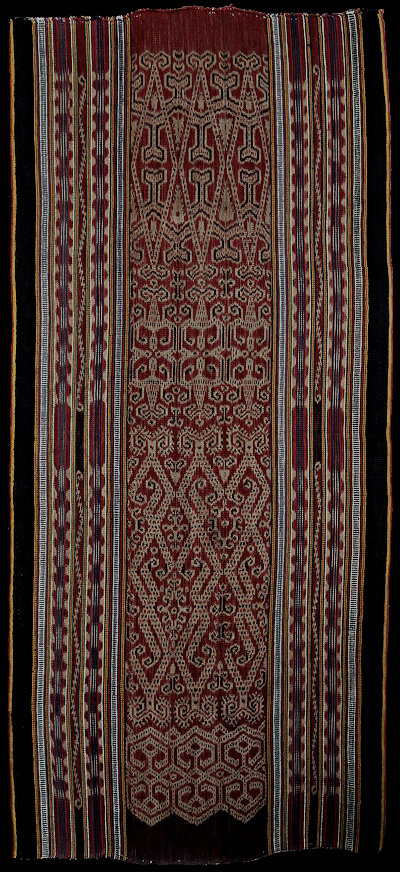| |
 
 | | | |
362 Borneo, Kalimantan
Kain kebat (skirt) 
| | Locale: | Ketungau | | Period: | 1900-1920 | | Yarn: | Cotton, hand-spun, fine | | Technique: | Warp ikat | | Panels: | 1 | | Size: | 54.5 x 120 cm (1' 9" x 3' 11") LW: 2.20 | | Weight: | 55 g (1.9 oz), 84 g/m2 (0.28 oz/ft2) | | Design: | This skirt has the division of the field in three areas with different designs that is characteristic for kain kebat from the Ketunga river region. Characteristic are also the two rows of hexagons which represent ossuaries.The section above is decorated with nagas, mythical snakes. Above them is a section anthropomorphic figures, the limbs turned inward. The motif of the third, top, section could not be identified. The centrefield's intricacy is balanced by the borders' graphic richness. Two lines of red ikat circles placed in parallel alignment are each bisected by four blue-white stripes woven in supplementary warp, which have also been ikatted: the combination of techniques is unusual and produces a purplish abrash and pulsing effect. Between the two lines of circles is a long undulating line of flecked ikat that may represent rattan. Multiple pinstripes (also hand-spun) in yellow, red, white and blue supplementary warp interspace the three borders, which are finally enclosed in slightly different flanking borders of ribbed blue-white alternating warp-faced float weave. The elaborate border sections combined with the closely spaced centrefield pattern create an overall concentrated, intense design. | | Comment: | [PHOTOGRAPHY PROVISIONAL] Rare example of the high class ikat design that was produced in the Ketungau river region around in the 19th and early 20th centuries. Remarkably, the weft alternates between twin morinda red and single indigo, which in the plain indigo bands along the selvedges creates a purplish, ribbed effect. The alternation of red and indigo weft was not observed anywhere else. Remarkable is also the extremely low specific weight of 84 g/m2, as of February 2021 the lowest by far of all cotton ikat textiles in the collection, with only PC 300, also from the Ketungau region, coming close. | | Background: | Chapters on Borneo and Kalimantan. | | Compare: | 212 242 300 317 | | |

©Peter ten Hoopen, 2024
All rights reserved.
|
|


